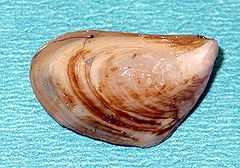Dreissenidae
| Dreissenidae | |
|---|---|
 | |
| Dreissena polymorpha | |
| Scientific classification | |
| Kingdom: | Animalia |
| Phylum: | Mollusca |
| Class: | Bivalvia |
| Subclass: | Heterodonta |
| Order: | Veneroida |
| Superfamily: | Dreissenoidea |
| Family: | Dreissenidae |
| Genera | |
|
Dreissena | |
The Dreissenidae are a family of small freshwater mussels, aquatic bivalve mollusks. They attach themselves to stones or to any other hard surface using a byssus.
Genera
Genera within the family Dreissenidae include:
- Congeria
- Dreissena, the type genus of the family
- Mytilopsis
Shell morphology

The shells of species of mussels in this family range from 20–40 mm in their maximum dimension, and about half as wide across. The shell outline is bent, with one margin usually somewhat incurved, and the other strongly curved outwardly. The shell is opaque and robust; in coloration it is yellowish, brownish or greyish, often with light-and-dark stripes.
Biology and ecology
These mussels breathe via complex gills. They live in clean, well oxygenated, lowland rivers, canals and reservoirs, attaching to stones and other hard surfaces; they will also tolerate slightly brackish water.
Geographical range of distribution
In Britain there is only one species from this family, Dreissena polymorpha, the zebra mussel, which is a troublesome invasive species. In the USA, both D. polymorpha and D. bugensis are problematic introduced species.